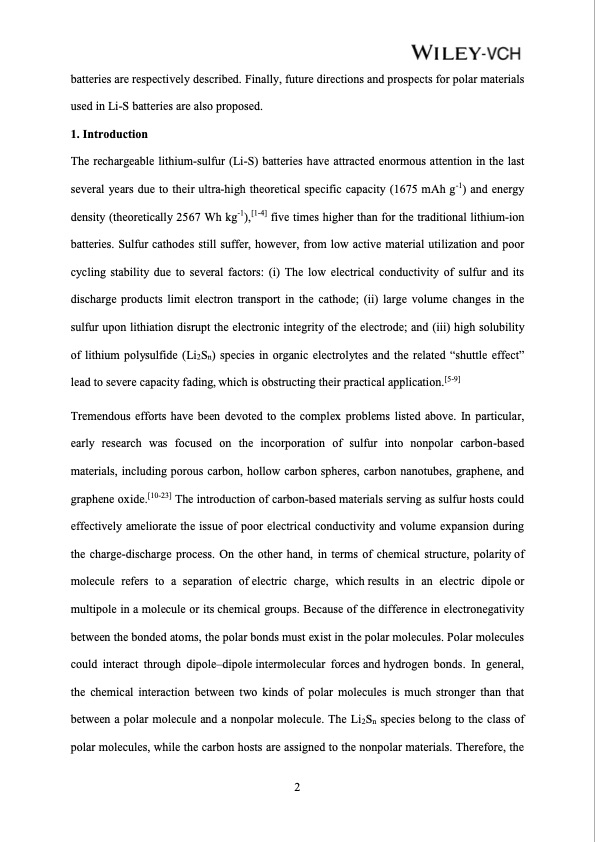
PDF Publication Title:
Text from PDF Page: 004
batteries are respectively described. Finally, future directions and prospects for polar materials used in Li-S batteries are also proposed. 1. Introduction The rechargeable lithium-sulfur (Li-S) batteries have attracted enormous attention in the last several years due to their ultra-high theoretical specific capacity (1675 mAh g-1) and energy density (theoretically 2567 Wh kg-1),[1-4] five times higher than for the traditional lithium-ion batteries. Sulfur cathodes still suffer, however, from low active material utilization and poor cycling stability due to several factors: (i) The low electrical conductivity of sulfur and its discharge products limit electron transport in the cathode; (ii) large volume changes in the sulfur upon lithiation disrupt the electronic integrity of the electrode; and (iii) high solubility of lithium polysulfide (Li2Sn) species in organic electrolytes and the related “shuttle effect” lead to severe capacity fading, which is obstructing their practical application.[5-9] Tremendous efforts have been devoted to the complex problems listed above. In particular, early research was focused on the incorporation of sulfur into nonpolar carbon-based materials, including porous carbon, hollow carbon spheres, carbon nanotubes, graphene, and graphene oxide.[10-23] The introduction of carbon-based materials serving as sulfur hosts could effectively ameliorate the issue of poor electrical conductivity and volume expansion during the charge-discharge process. On the other hand, in terms of chemical structure, polarity of molecule refers to a separation of electric charge, which results in an electric dipole or multipole in a molecule or its chemical groups. Because of the difference in electronegativity between the bonded atoms, the polar bonds must exist in the polar molecules. Polar molecules could interact through dipole–dipole intermolecular forces and hydrogen bonds. In general, the chemical interaction between two kinds of polar molecules is much stronger than that between a polar molecule and a nonpolar molecule. The Li2Sn species belong to the class of polar molecules, while the carbon hosts are assigned to the nonpolar materials. Therefore, the 2PDF Image | Advances in Polar Materials for Lithium-Sulfur Batteries

PDF Search Title:
Advances in Polar Materials for Lithium-Sulfur BatteriesOriginal File Name Searched:
212718644.pdfDIY PDF Search: Google It | Yahoo | Bing
Sulfur Deposition on Carbon Nanofibers using Supercritical CO2 Sulfur Deposition on Carbon Nanofibers using Supercritical CO2. Gamma sulfur also known as mother of pearl sulfur and nacreous sulfur... More Info
CO2 Organic Rankine Cycle Experimenter Platform The supercritical CO2 phase change system is both a heat pump and organic rankine cycle which can be used for those purposes and as a supercritical extractor for advanced subcritical and supercritical extraction technology. Uses include producing nanoparticles, precious metal CO2 extraction, lithium battery recycling, and other applications... More Info
| CONTACT TEL: 608-238-6001 Email: greg@infinityturbine.com | RSS | AMP |